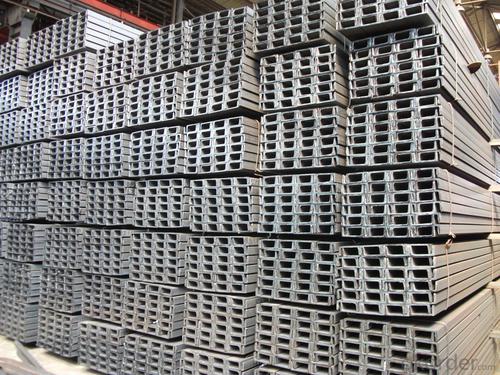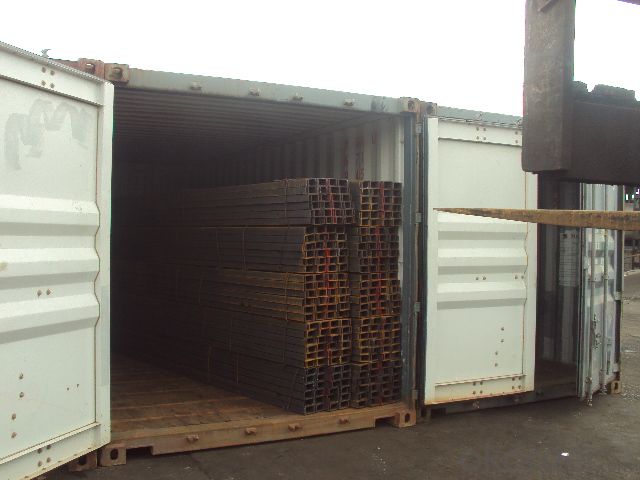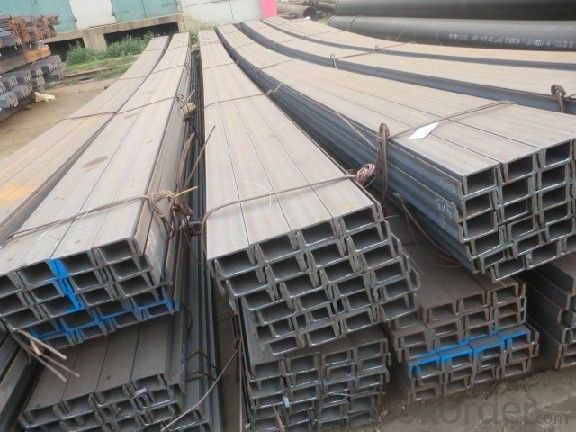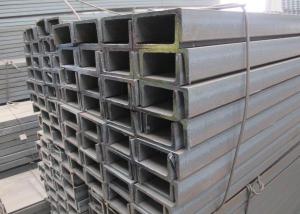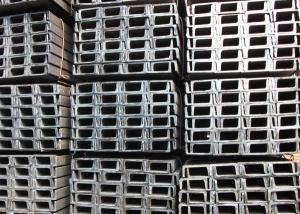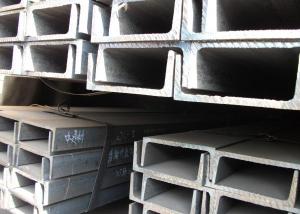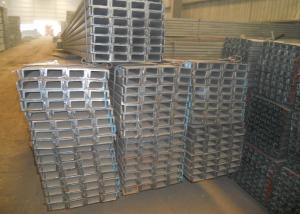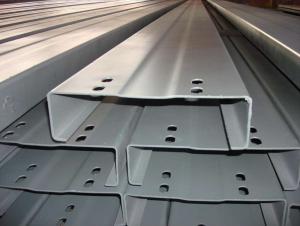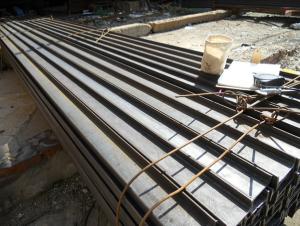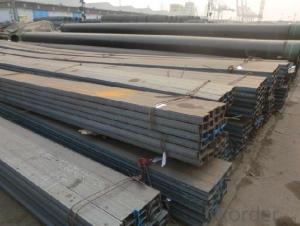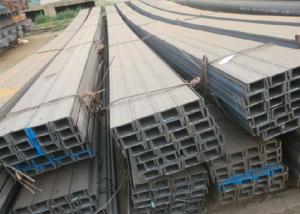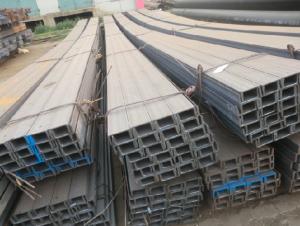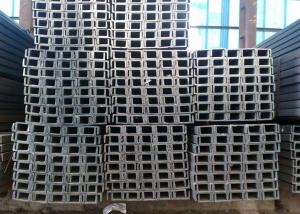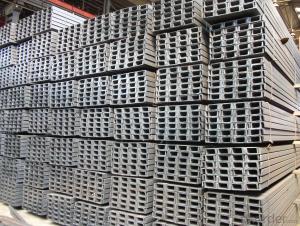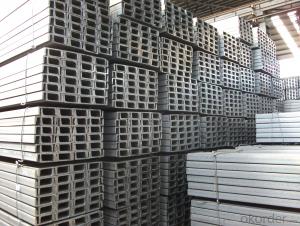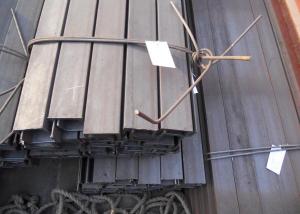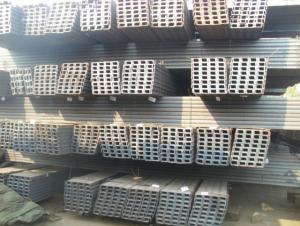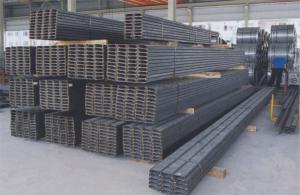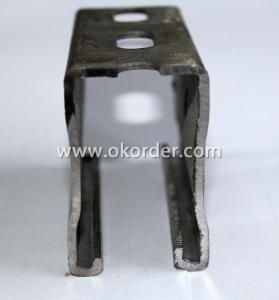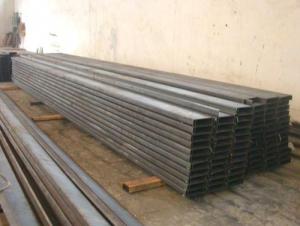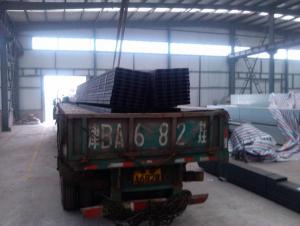channel
- Loading Port:
- China Main Port
- Payment Terms:
- TT OR LC
- Min Order Qty:
- -
- Supply Capability:
- -
OKorder Service Pledge
OKorder Financial Service
You Might Also Like
Product Description:
Specifications of MS Channel:
1.We supply high quality MS Channel at reasonable price, including Chinese standard, Japanese standard and so on.
Standard | GB/JIS |
Material Grade | Q235,SS400 |
Technique: | Hot Rolled |
Sizes as per chinese standard: | 50*37*4.5mm - 300*89*11.5mm |
Sizes as per japanese standard: | 50*25*3mm – 200*80*7.5mm |
Length: | 6meter, 9meter, 12meter |
Note: 1.we are also competent to provide our customers other MS Channel based on other sizes according to customer’s requirements.
2. The length of our ms channel could be cut into other meters as per customer’s requirements. For example, the channel in 6meters could be cut into 5.8meters in order to be fit in the 20ft container.
2. The detailed sections of MS Channel as per GB standard.are shown in the table-1:
GB U CHANNEL | Standard | Sectional | Dimension |
| Mass: |
| (mm) | (mm) | (mm) | (mm) |
|
50X37 | 50 | 37 | 4.50 | 7.0 | 5.438 |
63X40 | 63 | 40 | 4.80 | 7.5 | 6.634 |
80x43 | 80 | 43 | 5.00 | 8.0 | 8.045 |
|
|
|
|
|
|
100x48 | 100 | 48 | 5.30 | 8.5 | 10.007 |
120x53 | 120 | 53 | 5.50 | 9.0 | 12.059 |
140x58 | 140 | 58 | 6.00 | 9.5 | 14.535 |
140x60 | 140 | 60 | 8.00 | 9.5 | 16.733 |
|
|
|
|
|
|
160x63 | 160 | 63 | 6.50 | 10.0 | 17.240 |
160x65 | 160 | 65 | 8.50 | 10.0 | 19.752 |
|
|
|
|
|
|
180x68 | 180 | 68 | 7.00 | 10.5 | 20.174 |
180x70 | 180 | 70 | 9.00 | 10.5 | 23.000 |
|
|
|
|
|
|
200x73 | 200 | 73 | 7.00 | 11.0 | 22.637 |
200x75 | 200 | 75 | 9.00 | 11.0 | 25.777 |
|
|
|
|
|
|
220x77 | 220 | 77 | 7.00 | 11.5 | 24.999 |
220x79 | 220 | 79 | 9.00 | 11.5 | 28.453 |
|
|
|
|
|
|
250x78 | 250 | 78 | 7.00 | 12.0 | 27.410 |
250x80 | 250 | 80 | 9.00 | 12.0 | 31.335 |
250x82 | 250 | 82 | 11.00 | 12.0 | 35.260 |
|
|
|
|
| |
280x82 | 280 | 82 | 7.50 | 12.5 | 31.427 |
280x84 | 280 | 84 | 9.50 | 12.5 | 35.823 |
280x86 | 280 | 86 | 11.50 | 12.5 | 40.219 |
|
|
|
|
|
|
300x85 | 300 | 85 | 7.50 | 13.5 | 34.463 |
300x87 | 300 | 87 | 9.50 | 13.5 | 39.173 |
300x89 | 300 | 89 | 11.50 | 13.5 | 43.883 |
Table-1
3. The chemical composition of HR Channel Steel according to Q235B is shown in Table-2.
Alloy No | Grade | Element(%) | ||||
C | Mn | S | P | Si | ||
Q235 | B | 0.12-0.20 | 0.3-0.7 | ≦0.045 | ≦0.045 | ≦0.3 |
Table-2
Note: we are able to present our customers relevant SGS test report for chemical composition of HR Channel Steel.
4. The mechanical property of HR Channel Steel according to Q235B is shown in Table-3-1 and Table-3-2
Alloy No | Grade | Yielding Strength Point(Mpa) | |||
Thickness(mm) | |||||
≦16 | >16-40 | >40-60 | >60-100 | ||
≧ | |||||
Q235 | B | 235 | 225 | 215 | 205 |
Table-3-1
Alloy No | Grade | Tensile Strength(Mpa) | Elongation After Fracture(%) | |||
Thickness(mm) | ||||||
≦16 | >16-40 | >40-60 | >60-100 | |||
≧ | ||||||
G235 | B | 375-500 | 26 | 25 | 24 | 23 |
Table-3-2
Note: we are able to present our customers relevant SGS test report for mechanical property of MS Channel as customer’s request.
Applications of MS Channel:
The MS Channel can be applied to construction of warehouses, workshops, sport stadiums and car parks etc.The hot rolled channel steel belongs to carbon structural steel which is applied to in the field of construction and machinery.In details, the hot rolled channel steel is usually used for arch-itechtural structure, and they could be welded in order to support or hang a vari-ety of facilities. They are also usually used in combination with I beam. Generally,the hot rolled channel steel we supply must possess perfect welding property, riveting property and mechanical property and so on.
Package & Delivery of MS Channel:
1.The hot rolled channel steel will be packed in bundle with steel wire at each end of every bundle and color marking in order to help the customer to recognize his goods more easily at sight.
2. And the hot rolled channel steel could be loaded into 20ft or 40ft container, or by bulk cargo.If the weight of each bundle reaches more than 3.5 mt, the loading by break bulk cargo should be choosed.When the weight of each bundle reaches less than 3mt, the loading by container should be choosed.
3.As for the transportaion from mill to loading port, the truck will be usually used. And the maximum quantity for each truck is 40mt.
4.All in all, we could do in accordance with customer's request
- Q: Do steel channels have any specific safety considerations?
- Yes, steel channels have specific safety considerations that need to be taken into account. These include ensuring proper installation to prevent structural failure, regular inspection for signs of corrosion or damage, and implementing appropriate measures to prevent trips, slips, and falls when working around or on steel channels.
- Q: Can steel channels be used for signage installations?
- Signage installations can indeed utilize steel channels. These channels offer a strong and enduring framework that supports and mounts signage. They are widely employed in outdoor signage installations, including billboards, roadside signs, and large-scale displays. Due to their exceptional structural integrity, steel channels can withstand diverse weather conditions, guaranteeing the stability and long life of the signage. Moreover, steel channels can be tailored and crafted to meet the precise requirements of the signage, enabling accurate installation and alignment. All in all, steel channels are a dependable and resilient option for signage installations.
- Q: What are the precautions for handling and storing steel channels?
- When handling and storing steel channels, it is important to take certain precautions to ensure the safety of individuals and the integrity of the material. Here are some precautions to consider: 1. Personal Protective Equipment (PPE): Always wear appropriate PPE such as gloves, safety glasses, and steel-toed boots when handling steel channels. This will protect you from sharp edges, potential falls, and other hazards. 2. Lifting and handling: Use proper lifting techniques and equipment, such as cranes or forklifts, to move and transport steel channels. Avoid dragging or sliding them, as this can cause damage to the material or lead to accidents. 3. Secure storage: Store steel channels in a secure and organized manner to prevent them from falling or causing injury. Stack them on a flat surface or use racks designed for storing steel channels. Ensure that the storage area is free from moisture, direct sunlight, and extreme temperatures, as these can cause corrosion or distortion. 4. Weight capacity: Be aware of the weight capacity of the storage area or racks. Overloading them can result in collapse or damage to the material. 5. Rust prevention: Apply a protective coating or oil to the steel channels to prevent rust formation during storage. Regularly inspect and maintain the coating to ensure its effectiveness. 6. Separation and labeling: Separate different types and sizes of steel channels to prevent confusion and accidents. Clearly label each stack or rack with relevant information, such as size, weight, and grade, to facilitate easy identification. 7. Fire safety: Store steel channels away from flammable materials and ensure that the storage area is equipped with appropriate fire suppression systems and fire extinguishers. 8. Training and communication: Ensure that employees or individuals handling and storing steel channels are properly trained on the precautions and safety procedures. Encourage open communication and reporting of any concerns or incidents related to the handling and storage of steel channels. By following these precautions, you can minimize the risk of accidents, maintain the quality of the steel channels, and ensure a safe working environment for everyone involved.
- Q: The following steel is not section bar, is it? A. thread steel, B. steel pipe, C. track, D. channel steel
- The thread steel belongs to the small section steel, the track and the channel steel belong to the large section steel.According to the shape of the cross-section, the steel is generally divided into profiles, plates, pipes and metal products in four categories.Therefore, the steel pipe belongs to the pipe, not the profile.
- Q: What are the sustainability benefits of using steel channels?
- The utilization of steel channels brings forth a multitude of sustainability advantages. To begin with, steel is renowned as one of the most extensively recycled materials worldwide. This implies that by employing steel channels, the demand for fresh raw materials is diminished, as well as the energy consumption and greenhouse gas emissions associated with their extraction and production. By choosing steel channels, we have the ability to contribute to a circular economy and minimize waste generation. Furthermore, steel is widely recognized for its durability and long-lasting nature. Steel channels exhibit exceptional resistance to corrosion and can endure harsh environmental conditions, making them a sustainable choice for various applications. The durability of steel channels reduces the necessity for frequent replacements, thereby conserving resources and mitigating waste generation. Additionally, steel is an energy-efficient material. The production process of steel channels necessitates less energy in comparison to other construction materials such as concrete or aluminum. This energy efficiency results in lower carbon emissions during manufacturing, thereby contributing to an overall reduction in the carbon footprint. Moreover, steel channels can be easily repurposed and reused in diverse applications. This versatility enables the material to adapt to different uses, consequently minimizing the requirement for new production and reducing the environmental impact. Steel channels can be recycled and transformed into novel steel products, further prolonging their lifespan and decreasing the demand for virgin materials. Lastly, steel channels possess the advantageous characteristic of being lightweight when compared to other construction materials. This attribute reduces transportation costs, energy consumption during shipping, as well as the associated emissions. The selection of steel channels can make a valuable contribution to a more sustainable supply chain by mitigating carbon emissions and minimizing the environmental impact of logistics. In conclusion, the utilization of steel channels offers a multitude of sustainability benefits, including high recyclability, durability, energy efficiency, adaptability, and lightweight nature. By opting for steel channels, we have the capacity to contribute to a construction industry that is more sustainable and environmentally friendly.
- Q: What are the different types of welding for steel channels?
- There are several different types of welding commonly used for steel channels, including MIG (Metal Inert Gas) welding, TIG (Tungsten Inert Gas) welding, and stick welding. Each method has its own advantages and is chosen based on factors such as the thickness of the steel, the desired weld quality, and the available equipment and expertise. MIG welding is often preferred for its speed and ease of use, while TIG welding offers better control and produces cleaner welds. Stick welding, on the other hand, is a versatile method suitable for a wide range of steel thicknesses and can be used in outdoor or remote locations.
- Q: What are the different load distribution methods for steel channels in bridges?
- Steel channels in bridges commonly use several load distribution methods in engineering design to effectively distribute loads and stresses, ensuring structural integrity and safety. One simple method is the Equal Distribution Method, where the load is evenly distributed among all steel channels, resulting in uniform stress distribution. An alternative method is the Elastic Load Distribution Method, which distributes the load based on the elastic properties of the channels. Factors such as moment of inertia and modulus of elasticity determine the proportion of load each channel carries, favoring those with higher stiffness. The Influence Line Method is a graphical technique that analyzes the effects of a moving load on the bridge structure. By plotting the influence lines for different load positions, engineers can identify channels experiencing the highest stresses and adjust the load distribution accordingly. For more complex structures like bridges, Finite Element Analysis (FEA) is a numerical method that accurately simulates behaviors under different loading conditions. By considering factors such as geometry, material properties, and boundary conditions, FEA allows for precise load distribution calculations. Many countries have specific design codes and standards that provide guidelines for load distribution in bridge design. These codes consider factors like bridge type, span length, traffic loads, and environmental conditions, ensuring load distribution methods meet safety requirements. It is crucial to note that selecting the appropriate load distribution method depends on factors such as bridge design, expected loads, and desired safety level. Engineers must carefully consider these factors and use suitable methods to ensure optimal load distribution and structural performance in steel channel bridges.
- Q: What are the different methods of anti-slip treatment for steel channels?
- Some common methods of anti-slip treatment for steel channels include applying non-slip coatings or paints, using abrasive strips or tapes, welding on anti-slip gratings or plates, or using adhesive-backed anti-slip products.
- Q: What are the common maintenance requirements for steel channels?
- Some common maintenance requirements for steel channels include regular cleaning to remove dirt and debris, inspection for signs of corrosion or damage, and applying protective coatings or paints to prevent rusting. Additionally, ensuring proper drainage and preventing water accumulation can help prolong the lifespan of steel channels.
- Q: What are the different methods of insulation for steel channels?
- Steel channels can be insulated using various methods, each with its own advantages and applications. Some commonly used methods are: 1. Thermal insulation: By using materials with low thermal conductivity, heat transfer can be reduced. Examples of thermal insulation materials for steel channels include mineral wool, fiberglass, foam insulation, and reflective barriers. These materials effectively prevent heat loss or gain, ensuring energy efficiency and maintaining a comfortable temperature within the channel. 2. Spray foam insulation: This technique involves applying a liquid foam insulation material onto the steel channel's surface. The foam rapidly expands and solidifies, creating a seamless and airtight insulation layer. Spray foam insulation offers excellent thermal and moisture resistance, as well as soundproofing properties. It adheres well to irregular shapes, easily fills gaps and cracks, and is a versatile insulation method. 3. Insulated panels: Insulated panels are pre-fabricated panels with an insulating core sandwiched between two metal skins. These panels can be directly attached to steel channels, providing an instant and efficient insulation solution. Insulated panels offer excellent thermal performance, noise reduction, and fire resistance. They are lightweight, easy to install, and commonly used in commercial and industrial applications. 4. Insulation wraps: Insulation wraps are flexible materials that can be wrapped around steel channels to provide insulation. These wraps are typically made of fiberglass or mineral wool and come in various thicknesses and widths. Insulation wraps provide thermal and acoustic insulation, as well as protection against corrosion and condensation. They are easy to install and can be customized to fit different channel sizes and shapes. 5. Reflective insulation: Reflective insulation utilizes materials such as aluminum foil to reflect radiant heat away from the steel channel. This method is particularly effective in hot climates as it helps reduce heat gain. Reflective insulation can be installed as sheets, rolls, or panels and is often combined with other insulation methods to enhance overall thermal efficiency. 6. Ceramic insulation coatings: Ceramic insulation coatings are applied directly onto the steel channel's surface. These coatings consist of ceramic particles suspended in a binder, creating a heat-resistant barrier. Ceramic insulation coatings provide excellent thermal insulation and can withstand high temperatures. They are commonly used in industrial settings that require extreme heat or fire protection. Choosing the appropriate insulation method for steel channels depends on factors like desired thermal performance, budget, installation requirements, and specific application. It is important to consider the unique properties and benefits of each method to select the most suitable insulation solution.
Send your message to us
channel
- Loading Port:
- China Main Port
- Payment Terms:
- TT OR LC
- Min Order Qty:
- -
- Supply Capability:
- -
OKorder Service Pledge
OKorder Financial Service
Similar products
Hot products
Hot Searches
Related keywords



